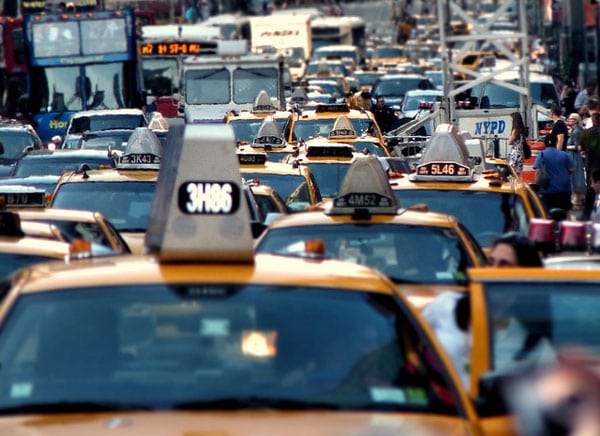
August 9, 2018; New York Times
This week, New York City “became the first major American city…to halt new vehicle licenses for ride-hail services,” reports Emma Fitzsimmons in the New York Times. The bill, Fitzsimmons adds, “passed overwhelmingly” on a 39–6 vote and “will cap the number of for-hire vehicles for a year while the city studies the booming industry. The bills also allow New York to set a minimum pay rate for drivers.”
The move by New York City to regulate ride-hailing services marks a major shift. Not so long ago, writers rhapsodized about the rise of the sharing economy. For example, in Fast Company seven years ago, Danielle Sacks wrote:
It’s 8:30 a.m. in Silicon Valley, and Neal Gorenflo is already busy sharing. Inside his Mountain View town house, just a few short blocks from the Caltrain station where commuters pour out each morning on their way to Google, Gorenflo hands over his 15-month-old son, Jake, to a nanny he shares with his neighbor. At a local coffee shop, he logs on to a peer-to-peer banking site called Lending Club to make a series of small loans to someone planning a wedding, another starting a pet business, and a guy named Pat who wants to move.
So, how’s the sharing going? While companies like Uber have grown exponentially, as Ginia Bellafante writes in the Times, the shortfalls are increasingly obvious. As Bellafante explains,
A study released last month from two economists, James A. Parrott and Michael Reich, indicated that in New York City, Uber’s largest domestic market, nearly two thirds of drivers who worked for ride-hailing services did so full time. They held no other jobs; approximately 80 percent bought cars for the purpose of making a living by driving them. Many were in debt from those acquisitions and making very little money.
Sign up for our free newsletters
Subscribe to NPQ's newsletters to have our top stories delivered directly to your inbox.
By signing up, you agree to our privacy policy and terms of use, and to receive messages from NPQ and our partners.
In their study, Parrott and Reich note that nine out of 10 drivers are immigrants. It is a struggling workforce. They add, “Forty percent of drivers have incomes so low they qualify for Medicaid and another 16 percent have no health insurance; 18 percent qualify for federal supplemental nutrition assistance (nearly twice the rate for New York City workers overall).”
Meanwhile, taxi drivers, who once enjoyed a stable “middle class” blue collar profession, suffer more. In the early 2000s, notes one taxi driver, “You could work nine hours and easily make $200 in a day. Now, you’re lucky if you make $50 or $60.” Bellafante notes that, “Six professional drivers killed themselves during the past several months, most recently, Abdul Saleh, a Yemeni immigrant who was found dead in a rented room in a Brooklyn apartment in June. He had been struggling for months to make payments on a leased cab.”
To get a sense of scale, the number of taxi cab medallions in New York City today is 13,587. In terms of rides, “Last October, Uber ridership surpassed that of yellow taxis, with Uber reporting an average of 289,000 rides per day, whereas yellow cabs only managed 277,000,” writes Ameena Walker for Curbed New York.
In their study, Parrott and Reich recommended a minimum wage of $17.22. Their recommendation—now passed by Council and which Mayor Bill de Blasio has pledged to sign into law on Tuesday—is supposed to be the equivalent of $15 an hour after expenses. As Bellafante notes, while the raise helps, it “must be considered within the context of the broader economics of a city where just to live affordably (which is to say, spending a third of your income on rent) in any of its five cheapest neighborhoods—all of them in the Bronx, all of them with median listed rents of $1,500 to $1,600 a month.” To afford these rents, “You need to earn between $54,000 and $58,000 a year,” Bellafante points out.
For Bellafante, “What is astonishing about the current legislation is how tepid so much of it actually is, and how ferociously it was fought by the companies involved. The cornerstone of the Council’s work caps, for just one year, the number of cars that can operate in the city…during the year the cap is effective, the city plans to study the economic and environmental impact further and it is allowing the various services to add wheelchair-accessible cars and vans in the meantime.”
Is there a structural intervention that can interrupt this sharing economy-induced poverty cycle? Last December in NPQ, MJ Kaplan suggested that one possible path forward is for drivers to become owners of the ride-hailing services themselves. “A driver-owned Uber would share the wealth far more equitably than an Uber controlled by venture capital investors,” Kaplan noted. New York City has already taken some steps to support worker co-op development. Applying this model in the ride-hailing industry might be a logical next step.—Steve Dubb











